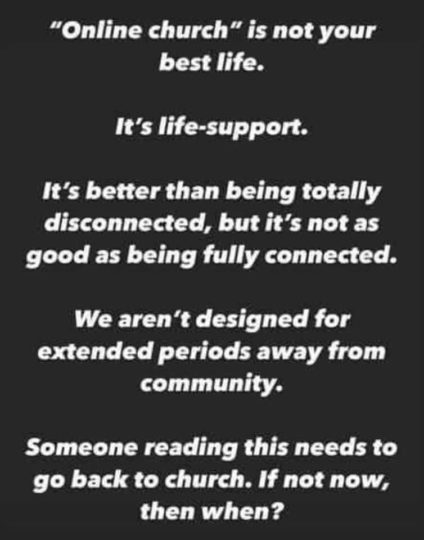“That’s the Way We’ve Always Done It.”
Pastors dread those words.
Pastors in their new assignments believe, understandably, that part of the reason that they are there (at their new assignment) is because they are new and will bring the new. As any new pastor quickly learns, however, the new is often only welcome when it fits within the established framework of the church pre-pastor.
An Easy One
My wife and I were recently called (or assigned) to a long-established church. During our interview with the church’s board, we asked, “what can’t we change?” It’s a dangerous question, but in many regards, I think it better than, “what do you want to do”, or “what is your vision?”
A framework is set. (What is now) Our church said, don’t change the time of the Sunday Service. That’s it. We warned them, “that’s a pretty small thing.” We can live with that time. Now, if God blesses our ministry and church (and we are faithful, of course), we may have to worry about the time, but that is for the future.
Adding
My wife and I are big into bringing Church Year and other liturgical elements into church life. This is not some mis-guided attempt at being Romanist or “High Church”, but we find meaning in it, and it helps tell the story of God in visual ways.
We’ve haven’t gone over-the-top, I think. We’ve done a bit of the colors and the Candle of the Presence (just added that). We are quick to say this is a symbol, a visual reminder or cue. Honestly, we probably won’t add much more. If one does too much, it all gets lost anyway and loses its meaning.
We’ll somewhat follow the lectionary, perhaps not for all the Scriptures, but to maintain the rhythm of the church year, which is valuable to tell all the story of God, rather than the choice parts.
Taking Away
Honestly, we haven’t done much of that. No real need to, that we see. However, there was a structural issue that resulted in the “erasing” of our library (mostly ignored) and an “office”. It was necessary for the health of people and the integrity of the building.
Things treasure had to be tossed. People’s “spaces” were removed. No promises have been made to restore them to what they were, instead we now ask, “what is God asking us to do with these spaces?” Meeting space? Chapel? Cry Room? It could be all of that.
This one was easy because of health and structure, but there will be hard ones.
The Hard Ones
As someone who is digitally-inclined, I’ve been pondering the future of digital and my (new) local church. Digital isn’t going away. How our little expression will “do” digital (other than a live stream) is yet to be determined. I will stil continue to do VR.
It is my wrestling with digital, though, that caused me to go down a different path of thinking and questioning.
Pastoral Introspection
Perhaps as the church wrestles with digital (more than merely live streaming or even web page content or video prayer meetings), we as the leaders (both pastors and non-pastors) need to recognize that much of our conversation about church, attendance, post-COVID “returns”, and the like is really us saying, “That’s the way we’ve always done it.”
The liturgy and church year customs are for some traditions, “that’s the way we’ve always done it.” As such, it has lost much of its power and become background noise, because “that’s the way they’ve always done it.” Of course, “always” is still not all that long ago.
We in the more evangelical Christian strains are just as bad. We’ve “always” had four songs, a prayer, and a sermon. The Evangelical Christian tradition has long elevated the sermon above almost everything else. The liturgical traditions (Orthodox, Roman Catholic, Anglican, Lutheran), often elevate the Eucharist (communion) over everything.
I believe (having experience much of it) that all are valuable. The danger always being that they become, “that’s the way we’ve always done it.” Thinking critically is always important.
Traditionalist Evangelical Christians (which, really, is only a century old, young in church years) are wrestling, again, with what the “new” church looks like, but keep looking at what use to be.
In other words, are pastors now the worst about, “that’s the way we’ve always done it?”
As someone who is bringing old (i.e., non-“traditional” Church of the Nazarene) stuff into the church, I regularly ask myself if I am bringing something both new (to this church) and old (tradition) because, “that’s the way they (the traditional-types) always did it,” or because it is something I believe will add to our people’s worship of God.
Stop Learning
I am regularly asking myself, “what do I need to unlearn?” We must be willing to unlearn.
For the last few decades in the Evangelical Christian church (especially, though not exclusively), we have focused on what new things, modes, methods, models, information we need to learn and implement. As we feel threatened by changes in the culture (morals, technology, other faiths, etc.), we want to hold onto what we know, because we view it as safe, at it worked before.
This was the impact of a knowledge culture upon the church. We were deeply impacted by the knowledge culture.
Some say the current culture is now an experience culture. They might be right. So much of what we are seeing is an emotive culture. The funny thing is, though, that the church thought this was the way to get people to Jesus not that long ago.
We’re learning. We’re learning to unlearn.
We’re unlearning emotive worship. We’re unlearning that “just one more Bible Study” or “one more curriculum” will save the church.
Some churches are unlearning that (“traditional”) Sunday morning service is the most effective way of being church. Some churches are unlearning that most of their efforts and expenditures must be spent for Sunday.
Some churches are unlearning that in-person is best on Sunday rather than other days and times. Some churches are unlearning the physical centralized gathering by replacing it with digital and then releasing the people to be the church in the world.
Concluding Thoughts
As we try to figure out what’s next, I want us to ask ourselves, “what do I(we) need to unlearn?” We must recognize that the splinter (“That’s the way we’ve always done it”) in others’ eyes may well be (and probably is) a plank in our own (see Luke 6:41–42 or Matthew 7:3–5).







